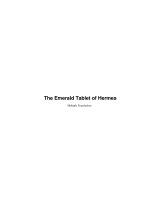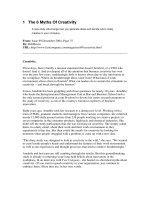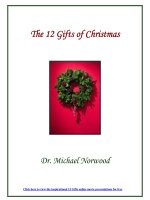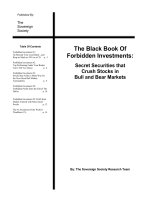Tài liệu The Emerald Tablet of Hermes pdf
Bạn đang xem bản rút gọn của tài liệu. Xem và tải ngay bản đầy đủ của tài liệu tại đây (51.79 KB, 22 trang )
The Emerald Tablet of Hermes
Multiple Translations
Table of Contents
The Emerald Tablet of Hermes.........................................................................................................................1
Multiple Translations...............................................................................................................................1
History of the Tablet................................................................................................................................1
Translations From Jabir ibn Hayyan.......................................................................................................2
Another Arabic Version (from the German of Ruska, translated by 'Anonymous')...............................3
Twelfth Century Latin..............................................................................................................................3
Translation from Aurelium Occultae Philosophorum..Georgio Beato...................................................4
Translation of Issac Newton c. 1680........................................................................................................5
Translation from Kriegsmann (?) alledgedly from the Phoenician........................................................6
From Sigismund Bacstrom (allegedly translated from Chaldean)..........................................................7
From Madame Blavatsky.........................................................................................................................8
From Fulcanelli (translated from the French by Sieveking)...................................................................8
From Fulcanelli, new translation.............................................................................................................9
From Idres Shah.....................................................................................................................................10
Hypothetical Chinese Original...............................................................................................................10
TEXTUAL REMARKS.........................................................................................................................11
COMMENTARIES...............................................................................................................................12
General...................................................................................................................................................16
A COMMENTARY OF IBN UMAIL...................................................................................................17
APPENDIX............................................................................................................................................18
Translation of same source, made c. 1485............................................................................................18
BIBLIOGRAPHY..................................................................................................................................19
The Emerald Tablet of Hermes
i
The Emerald Tablet of Hermes
Multiple Translations
This page copyright © 2002 Blackmask Online.
• History of the Tablet
• Translations From Jabir ibn Hayyan.
• Another Arabic Version (from the German of Ruska, translated by 'Anonymous').
• Twelfth Century Latin
• Translation from Aurelium Occultae Philosophorum..Georgio Beato
• Translation of Issac Newton c. 1680.
• Translation from Kriegsmann (?) alledgedly from the Phoenician
• From Sigismund Bacstrom (allegedly translated from Chaldean).
• From Madame Blavatsky
• From Fulcanelli (translated from the French by Sieveking)
• From Fulcanelli, new translation
• From Idres Shah
• Hypothetical Chinese Original
• TEXTUAL REMARKS
• COMMENTARIES
• General
• A COMMENTARY OF IBN UMAIL
• APPENDIX
• Translation of same source, made c. 1485.
• BIBLIOGRAPHY
History of the Tablet
History of the Tablet (largely summarised from Needham 1980, Holmyard 1957)
The Tablet probably first appeared in the West in editions of the psuedo−Aristotlean Secretum Secretorum
which was actually a translation of the Kitab Sirr al−Asar, a book of advice to kings which was translated
into latin by Johannes Hispalensis c. 1140 and by Philip of Tripoli c.1243.
Other translations of the Tablet may have been made during the same period by Plato of Tivoli and Hugh of
Santalla, perhaps from different sources.
The date of the Kitab Sirr al−Asar is uncertain, though c.800 has been suggested and it is not clear when the
tablet became part of this work.
Holmyard was the first to find another early arabic version (Ruska found a 12th centruy recension claiming to
have been dictated by Sergius of Nablus) in the Kitab Ustuqus al−Uss al−Thani (Second Book of the
Elements of Foundation) attributed to Jabir. Shortly after Ruska found another version appended to the Kitab
Sirr al−Khaliqa wa San`at al−Tabi`a (Book of the Secret of Creation and the Art of Nature), which is also
known as the Kitab Balaniyus al−Hakim fi'l−`Ilal (book of Balinas the wise on the Causes). It has been
The Emerald Tablet of Hermes 1
proposed that this book was written may have been written as early as 650, and was definitely finished by the
Caliphate of al−Ma'mun (813−33).
Scholars have seen similarities between this book and the Syriac Book of Treasures written by Job of Odessa
(9th century) and more interestingly the Greek writings of the bishop Nemesius of Emesa in Syria from the
mid fourth century. However though this suggests a possible Syriac source, non of these writings contain the
tablet.
Balinas is usually identified with Apollonius of Tyna, but there is little evidence to connect him with the
Kitab Balabiyus, and even if there was,the story implies that Balinas found the tablet rather than wrote it, and
the recent discoveries of the dead sea scrolls and the nag hamamdi texts suggest that hiding texts in caves is
not impossible, even if we did not have the pyramids before us.
Ruska has suggested an origin further east, and Needham has proposed an origin in China.
Holmyard, Davis and Anon all consider that this Tablet may be one of the earliest of all alchemical works we
have that survives.
It should be remarked that apparantly the Greeks and Egyptians used the termtranslated as `emerald' for
emeralds, green granites, "and perhaps green jasper". In medieval times the emerald table of the Gothic kings
of Spain, and the Sacro catino− a dish said to have belonged to the Queen of Sheba, to have been used at the
last supper, and to be made of emerald, were made of green glass [Steele and Singer: 488].
Translations From Jabir ibn Hayyan.
0) Balinas mentions the engraving on the table in the hand of Hermes, which says:
1) Truth! Certainty! That in which there is no doubt!
2) That which is above is from that which is below, and that which is below is from that which is above,
working the miracles of one.
3) As all things were from one.
4) Its father is the Sun and its mother the Moon.
5) The Earth carried it in her belly, and the Wind nourished it in her belly, 7) as Earth which shall become
Fire.
7a) Feed the Earth from that which is subtle, with the greatest power.
8) It ascends from the earth to the heaven and becomes ruler over that which is above and that which is
below.
14) And I have already explained the meaning of the whole of this in two of these books of mine.
[Holmyard 1923: 562.]
The Emerald Tablet of Hermes
Translations From Jabir ibn Hayyan. 2
Another Arabic Version (from the German of Ruska, translated by
'Anonymous').
0) Here is that which the priest Sagijus of Nabulus has dictated concerning the entrance of Balinas into the
hidden chamber... After my entrance into the chamber, where the talisman was set up, I came up to an old
man sitting on a golden throne, who was holding an emerald table in one hand.
And behold the followingin Syriac, the primordial language− was written thereon:
1) Here (is) a true explanation, concerning which there can be no doubt.
2) It attests: The above from the below, and the below from the above −the work of the miracle of the One.
3) And things have been from this primal substance through a single act. How wonderful is this work! It is
the main (principle) of the world and is its maintainer.
4) Its father is the sun and its mother the moon; the
5) wind has borne it in its body, and the earth has nourished it.
6) the father of talismen and the protector of miracles
6a) whose powers are perfect, and whose lights are confirmed (?),
7) a fire that becomes earth.
7a) Separate the earth from the fire, so you will attain the subtle as more inherent than the gross, with care
and sagacity.
8) It rises from earth to heaven, so as to draw the lights of the heights to itself, and descends to the earth; thus
within it are the forces of the above and the below;
9) because the light of lights within it, thus does the darkness flee before it.
10) The force of forces, which overcomes every subtle thing and penetrates into everything gross.
11) The structure of the microcosm is in accordance with the structure of the macrocosm.
12) And accordingly proceed the knowledgeable.
13) And to this aspired Hermes, who was threefold graced with wisdom.
14) And this is his last book, which he concealed in the chamber.
[Anon 1985: 24−5]
Twelfth Century Latin
0) When I entered into the cave, I received the tablet zaradi, which was inscribed, from between the hands of
Hermes, in which I discovered these words:
The Emerald Tablet of Hermes
Another Arabic Version (from the German of Ruska, translated by 'Anonymous'). 3
1) True, without falsehood, certain, most certain.
2) What is above is like what is below, and what is below is like that which is above. To make the miracle of
the one thing.
3) And as all things were made from contemplation of one, so all things were born from one adaptation.
4) Its father is the Sun, its mother is the Moon.
5) The wind carried it in its womb, the earth breast fed it.
6) It is the father of all 'works of wonder' (Telesmi) in the world.
6a) Its power is complete (integra).
7) If cast to (turned towards− versa fuerit) earth,
7a) it will separate earth from fire, the subtile from the gross.
8) With great capacity it ascends from earth to heaven. Again it descends to earth, and takes back the power
of the above and the below.
9) Thus you will receive the glory of the distinctiveness of the world. All obscurity will flee from you.
10) This is the whole most strong strength of all strength, for it overcomes all subtle things, and penetrates all
solid things.
11a) Thus was the world created.
12) From this comes marvelous adaptions of which this is the proceedure.
13) Therefore I am called Hermes, because I have three parts of the wisdom of the whole world.
14) And complete is what I had to say about the work of the Sun, from the book of Galieni Alfachimi.
[From Latin in Steele and Singer 1928: 492.]
Translation from Aurelium Occultae Philosophorum..Georgio Beato
1) This is true and remote from all cover of falsehood
2) Whatever is below is similar to that which is above. Through this the marvels of the work of one thing are
procured and perfected.
3) Also, as all things are made from one, by the condsideration of one, so all things were made from this one,
by conjunction.
4) The father of it is the sun, the mother the moon.
5) The wind bore it in the womb. Its nurse is the earth, the mother of all perfection.
The Emerald Tablet of Hermes
Translation from Aurelium Occultae Philosophorum..Georgio Beato 4
6a)Its power is perfected.
7) If it is turned into earth,
7a) separate the earth from the fire, the subtle and thin from the crude and course, prudently, with modesty
and wisdom.
8) This ascends from the earth into the sky and again descends from the sky to the earth, and receives the
power and efficacy of things above and of things below.
9) By this means you will acquire the glory of the whole world, and so you will drive away all shadows and
blindness.
10) For this by its fortitude snatches the palm from all other fortitude and power. For it is able to penetrate
and subdue everything subtle and everything crude and hard.
11a) By this means the world was founded
12) and hence the marvelous cojunctions of it and admirable effects, since this is the way by which these
marvels may be brought about.
13) And because of this they have called me Hermes Tristmegistus since I have the three parts of the wisdom
and Philsosphy of the whole universe.
14) My speech is finished which I have spoken concerning the solar work [Davis 1926: 874.]
Translation of Issac Newton c. 1680.
1) Tis true without lying, certain most true.
2) That wch is below is like that wch is above that wch is above is like yt wch is below to do ye miracles of
one only thing.
3) And as all things have been arose from one by ye mediation of one: so all things have their birth from this
one thing by adaptation.
4) The Sun is its father, the moon its mother,
5) the wind hath carried it in its belly, the earth its nourse.
6) The father of all perfection in ye whole world is here.
7) Its force or power is entire if it be converted into earth.
7a) Seperate thou ye earth from ye fire, ye subtile from the gross sweetly wth great indoustry.
8) It ascends from ye earth to ye heaven again it desends to ye earth and receives ye force of things superior
inferior.
9) By this means you shall have ye glory of ye whole world thereby all obscurity shall fly from you.
The Emerald Tablet of Hermes
Translation of Issac Newton c. 1680. 5
10) Its force is above all force. ffor it vanquishes every subtile thing penetrates every solid thing.
11a) So was ye world created.
12) From this are do come admirable adaptaions whereof ye means (Or process) is here in this.
13) Hence I am called Hermes Trismegist, having the three parts of ye philosophy of ye whole world.
14) That wch I have said of ye operation of ye Sun is accomplished ended.
[Dobbs 1988: 183−4.]
Translation from Kriegsmann (?) alledgedly from the Phoenician
1) I speak truly, not falsely, certainly and most truly
2) These things below with those above and those with these join forces again so that they produce a single
thing the most wonderful of all.
3)And as the whole universe was brought forth from one by the word of one GOD, so also all things are
regenerated perpetually from this one according to the disposition of Nature.
4) It has the Sun for father and the Moon for mother:
5) it is carried by the air as if in a womb, it is nursed by the earth.
6) It is the cause, this, of all perfection of all things throughout the universe.
6a) This will attain the highest perfection of powers
7) if it shall be reduced into earth
7a) Distribute here the earth and there the fire, thin out the density of this the suavest (suavissima) thing of
all.
8)Ascend with the greatest sagacity of genius from the earth into the sky, and thence descend again to the
earth, and recognise that the forces of things above and of things below are one,
9) so as to posses the glory of the whole world− and beyond this man of abject fate may have nothing further.
10)This thing itself presently comes forth stronger by reasons of this fortitude: it subdues all bodies surely,
whether tenuous or solid, by penetrating them.
11a) And so everything whatsoever that the world contains was created.
12) Hence admirable works are accomplished which are instituted (carried out− instituuntur) according to the
same mode.
13) To me therefor the name of Hermes Trismegistus has been awarded because I am discovered as the
Teacher of the three parts of the wisdom of the world.
The Emerald Tablet of Hermes
Translation from Kriegsmann (?) alledgedly from the Phoenician 6









